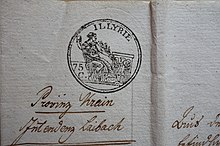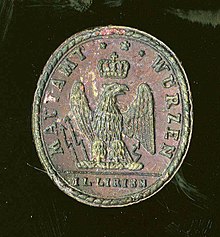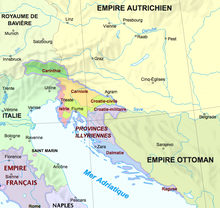Illyrian provinces
Illyrian provinces ( French Provinces Illyriennes ; Italian Provincie Illiriche ; Slovenian Ilirske province ; Croatian Ilirske pokrajne ) denotes areas on the east coast of the Adriatic and in the Eastern Alps , which were conquered by France between 1807 and 1809 and annexed together . The name is derived from the Illyrians , who at that time were held to be the direct ancestors of the southern Slavs .
The French administrative unit was in 1809 after the Treaty of Schönbrunn by decree Emperor Napoleon I created. It included the former Republic of Ragusa , the Venetian possessions in Dalmatia and Istria until 1797 and the Habsburg possessions in Istria, Fiume , Carniola , Carinthia ( Villach district ), Gorizia , Trieste , western civil Croatia and the Croatian military border between the Sava and the Adriatic. After the suppression of the Tyrolean uprising , the East Tyrolean districts of Lienz and Sillian were added on February 28, 1810 .
The Illyrian provinces covered about 55,000 km² with an elongated north-south extension of 750 km with about 1.5 million inhabitants, mainly Slovenes , Croats , Germans , Italians and Serbs . The capital was Laibach .
In winter 1813 / 1814 the Illyrian Provinces were of Austrian occupying troops and 1,815 at the Congress of Vienna, then Austria granted that the areas further joined to it a Kingdom of Illyria to form.
The short-term existence of the Illyrian provinces was significant for Illyrism , the South Slav unification movement.
history

After their French conquest, Dalmatia and Istria were initially united with the Kingdom of Italy in 1805 . After the Second Napoleonic War , Austria should have handed over Dalmatia and the Bay of Kotor to France in accordance with the Peace of Pressburg in 1806 . The French were too slow in taking Dalmatia and several cities missed handover dates. Contrary to the Treaty of Pressburg, the Bay of Kotor was handed over to the Principality of Montenegro .
After the French victory at Wagram in the 3rd Napoleonic War and the subsequent Treaty of Schönbrunn , the formation of the Illyrian provinces was ordered on October 14, 1809, the day the peace treaty was signed, by a decree of Emperor Napoleon to manage the annexed ones to steer Austrian territories in an orderly manner. These were partly areas of the kingdoms of Croatia and Dalmatia , which from 1767 to 1777 - together with the Kingdom of Slavonia - were called the Kingdom of Illyria . Laibach became the capital and seat of the French Governor General .
The British Navy blocked the Adriatic coast, which was under Napoleonic rule, from 1807. The British also occupied the island of Lissa ( Vis ), which is far from the coast , and used it as a base for their ships.

Austria declared war on France again in August 1813 ( 4th Napoleonic War ), and immediately afterwards troops under General Franz Tomassich advanced to the north of the Illyrian provinces. The few French troops offered hardly any resistance and on September 20th the Austrians marched into Ragusa ( Dubrovnik ). Only the strongly fortified Zara ( Zadar ) could the French hold longer. The fortress surrendered on December 6, 1813. Meanwhile, the Montenegrins had occupied Cattaro ( Kotor ). This city was not captured by the Austrians until June 1814.
The Congress of Vienna confirmed to the Austrian Empire that it owned all the countries it had won through the Peace of Campo Formio . On August 3, 1816, the majority of the territory of the Illyrian Provinces was constituted as the Kingdom of Illyria by an imperial resolution .
administration
At the head of the French administration of the Illyrian provinces stood a governor general, the general manager and the judiciary. Together they formed the government .
The office of governor general was held from October 1809 to January 1811 by Auguste de Marmont . He was followed in April 1811 by Henri-Gratien Bertrand and in February 1812 Jean-Andoche Junot took over the office. The last governor general was Joseph Fouché in July and August 1813 .

The French gradually introduced French legislation, the Civil Code in January 1812, and enforced the emancipation of Jews. In addition to French and German, the laws were also published in the “Slavonian language”. This meant a form of the not yet codified Slovene or Croatian. This had a particularly beneficial effect on the later development of the Slovene written language . The school system in the national languages was also promoted.
As everywhere in the French Empire, regional administration was to be organized in departments . Until the end of French rule, however, this project could not be fully implemented. Rather, so-called directorships were formed temporarily (initially eleven, later reduced to seven), which were largely based on older administrative boundaries:
- Organization from 1809 to 1811
| Surname | main place |
|---|---|
|
Adelsberg (Postojna) |
Adelsberg (Postojna) |
|
Bouches-du-Cattaro ("Estuaries of Cattaro") |
Cattaro (Kotor) |
|
Croatie (Croatia) |
Karlstadt (Karlovac) |
|
Dalmatia (Dalmatia) |
Zara (Zadar) |
| Fiume | Fiume (Rijeka) |
|
Gorice (Gorizia) |
Gorizia (Gorizia) |
|
Laybach (Laibach, Ljubljana) |
Laybach (Laibach, Ljubljana) |
|
Neustadt (Rudolfswerth, Novo mesto) |
New Town (Novo mesto) |
|
Raguse (Ragusa) |
Ragusa (Dubrovnik) |
| Trieste | Trieste (Trieste) |
|
Willach (Villach, Upper Carinthia and East Tyrol) |
Willach (Villach) |
- 1. Reorganization from 1811
- initially in four directorships of
- Laybach (Ljubljana)
- Karlstadt (Karlovac)
- Trieste
- Zara (Zadar)
- 2. Reorganization on April 15, 1811
- seven directorates with subordinate circles ( subdélégations ):
| Surname | main place | Subdélégations (circles) | Previous organization |
|---|---|---|---|
|
Carinthie ("Carinthia") |
Willach (Villach) | Willach Lienz |
formed from Willach (Upper Carinthia and East Tyrol) |
|
Carniole (Carniola) |
Laybach (Laibach, Ljubljana) | Adelsberg (Postojna) Laybach (Ljubljana) Kraimbourg (Krainburg) (now: Kranj) Neustadt (actually: Neustadtl, now: Novo Mesto) |
formed from Adelsberg , Laybach , Neustadt |
|
Croatie civile (civil Croatia) |
Karlstadt (Karlovac) |
Karlstadt Fiume (Rijeka), Lussinpiccolo (Mali Lošinj) |
formed from Fiume and part of Croatie |
|
Croatie militaire (Military Croatia) |
Segna (Zengg, now: Senj) | formed from part of Croatie | |
|
Istrie (Istria) |
Trieste | Trieste Gorizia (Görz) Capodistria (Koper) , Rovigno (Rovinj) |
formed from Trieste and Gorice |
|
Dalmatia (Dalmatia) |
Zara (Zadar) | Zara Spalato (Split) Lesina (Hvar) Sebenico (Šibenik) Macarsca |
formed from Dalmatia |
|
Raguse (Ragusa) |
Ragusa (Dubrovnik) | Ragusa Cattaro (Kotor) Curzola (Korčula) |
formed from Bouches-du-Cattaro and Raguse |
literature
- F. Šanjek (ed.): Hrvati i Ilirske pokrajine (1809. – 1813.): Zbornik radova s Međunarodnoga znanstvenog skupa Hrvatske Akademije Znanosti i Umjetnosti prigodom dvjestote obljetnice proglašenja Iljirinah . Zagreb 2010.
- Frank J. Bundy: The Administration of the Illyrian Provinces of the French Empire, 1809-1813 . New York 1987, ISBN 0-8240-8032-7 .
- Melitta Pivec stele: La vie économique des Provinces illyriennes (1809-1813): suivi d'une bibliographie critique . Paris 1930.
- George J. Prpić: French Rule in Croatia: 1806-1813 . In: Balkan Studies . No. 5 , 1964, pp. 221-276 .
- Reinhard A. Stauber: The Illyrian Provinces . In: The Napoleonic Empire and the New European Political Culture (War, Culture and Society, 1750-1850) . Houndmills 2012, p. 241-253 .
- Rok Stergar: Nation-building processes and new borders: The collapse of French rule in the Illyrian provinces and their (re) integration into the Austrian Empire . In: On the edge of big politics: Italy and the Alpine region at the Congress of Vienna . Innsbruck 2017, p. 97-122 .
- Janez Šumrada: Državnopravni status Ilirskih provinc s kratkim pregledom upravne ureditve . In: Vilfanov zbornik: pravo, zgodovina, narod = law, history, nation . Ljubljana 1999.
Individual evidence
- ^ A b Robin Harris: Dubrovnik: A history . Saqi-Books, London 2006, ISBN 0-86356-959-5 .

